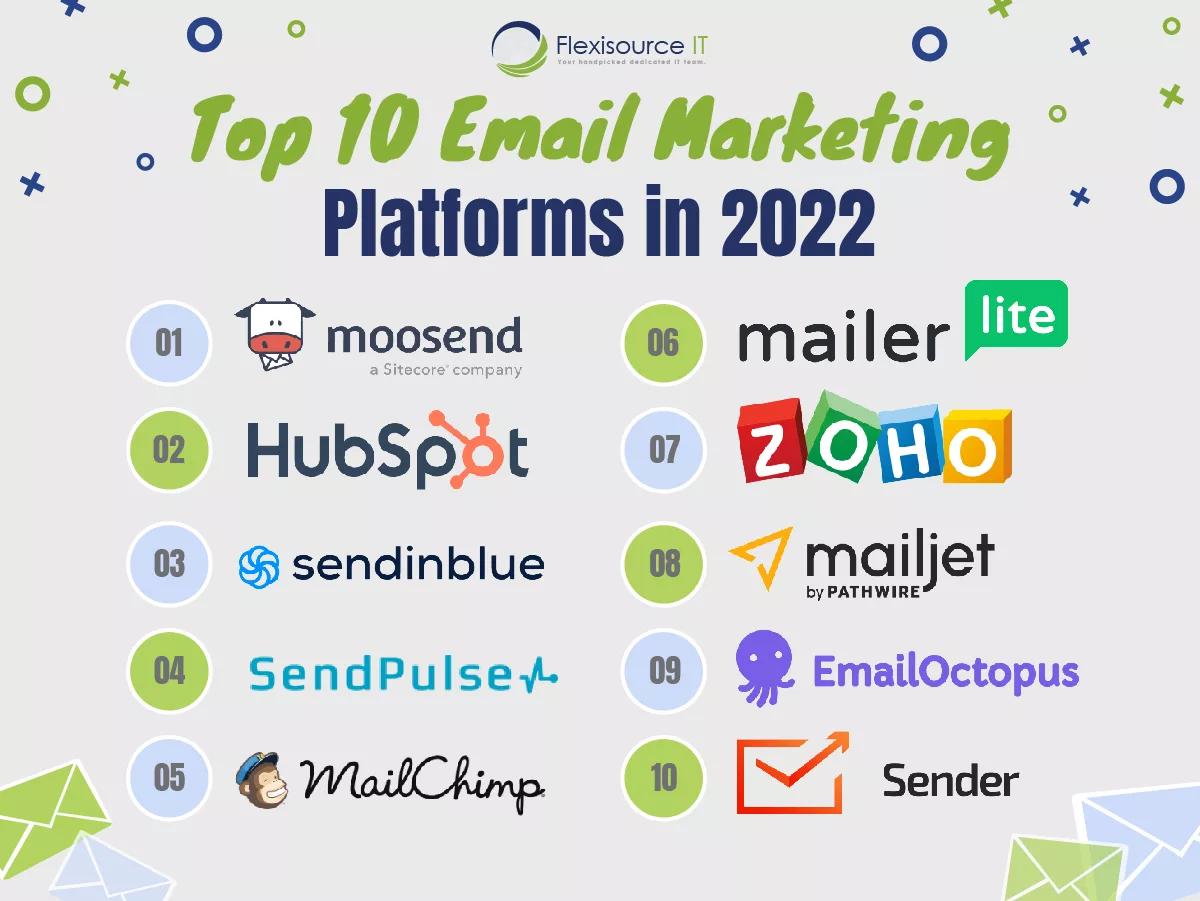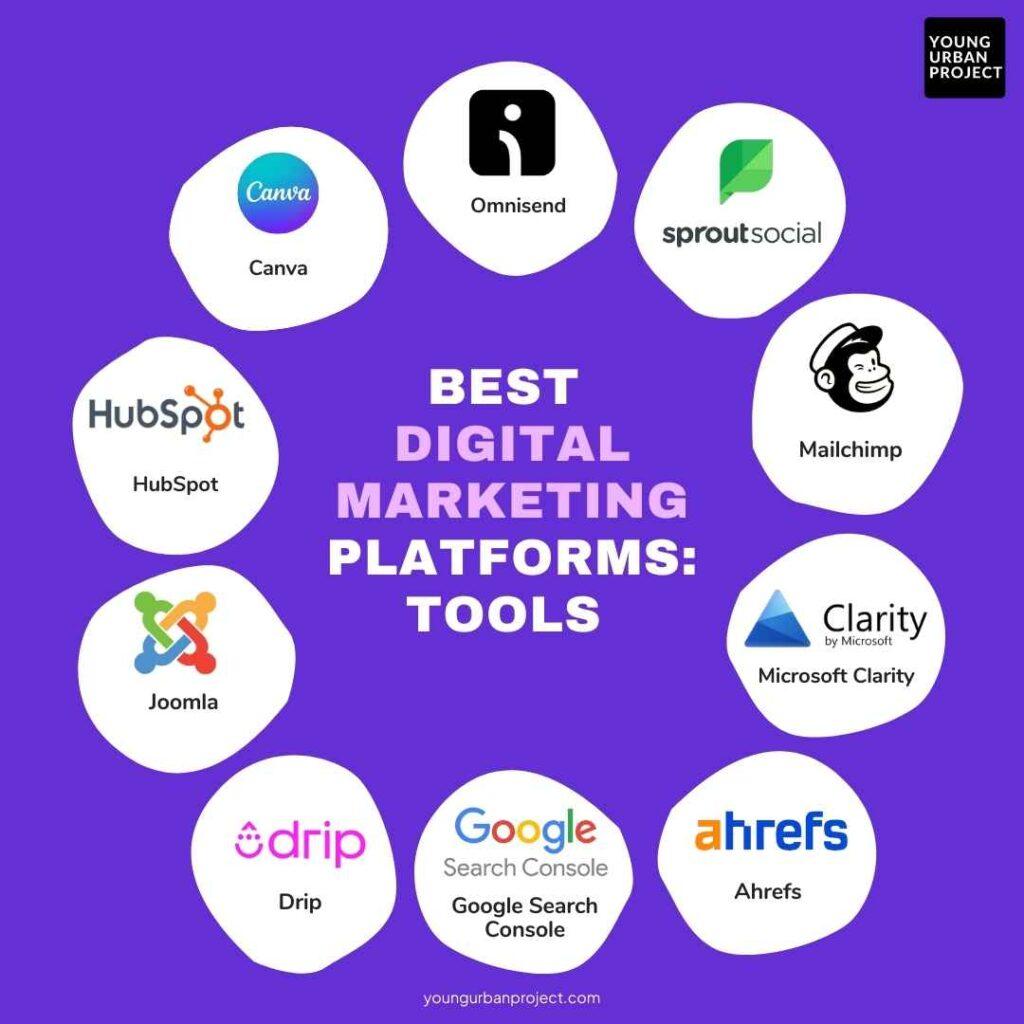Introduction:
In today’s digital world, email marketing remains one of the most effective ways to connect with your audience and drive engagement. Whether you’re a small business owner, a marketing professional, or an aspiring entrepreneur, finding the right email marketing platform can make all the difference in your campaign’s success. With so many options out there, navigating the sea of features, pricing plans, and user experiences can feel overwhelming. But don’t worry; we’ve got your back! In this guide, we’ll walk you through the 14 best email marketing platforms available today, each offering unique features to help you craft compelling campaigns that resonate with your audience. From intuitive design tools to powerful automation capabilities, these platforms are designed to help you maximize your reach and drive conversions. So, grab a cup of coffee, settle in, and let’s find the perfect email marketing solution for you!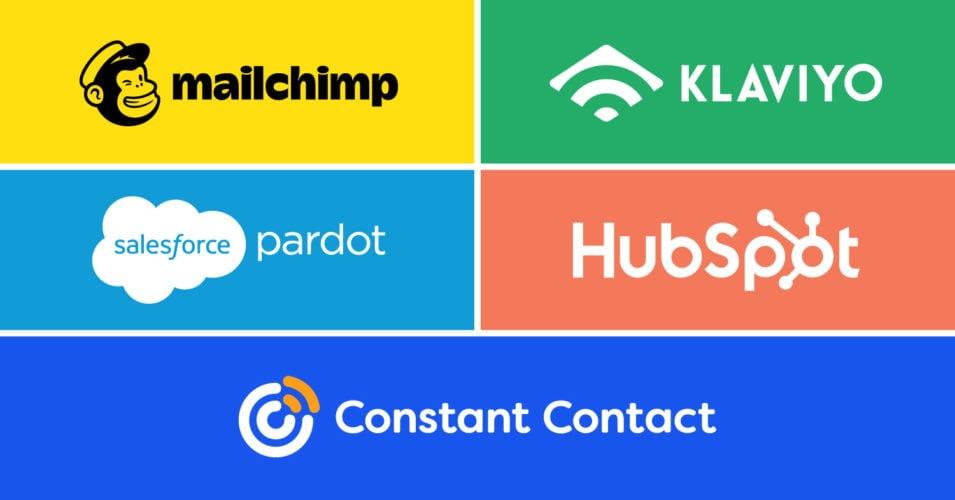
Choosing the Right Email Marketing Platform for Your Needs
When it comes to choosing an email marketing platform,it’s essential to align your selection with your specific needs and goals. With so many options available, the right choice can significantly enhance your marketing efforts and improve customer engagement.Here are some vital factors to consider:
- User-Friendliness: A platform with an intuitive interface can save you time and reduce frustration. Look for drag-and-drop editors that allow you to create lovely emails without needing advanced coding skills.
- Pricing: Many platforms offer tiered pricing models. Evaluate your budget and consider options that provide a good balance of features and cost. Free trials can also help you gauge the platform’s value before making a commitment.
- Automation Features: Automation can streamline your marketing campaigns.Look for platforms that offer robust automation capabilities,enabling you to send timely,personalized messages based on user behavior.
- integrations: Ensure the platform can seamlessly integrate with your existing tools, such as CRM systems and e-commerce platforms. This can enhance your marketing strategy by allowing for better data management and campaign tracking.
- Analytics and Reporting: Access to detailed analytics helps you understand campaign performance. Choose a platform that provides complete reporting features to analyze open rates, click-through rates, and conversions.
- Customer Support: Reliable customer support can be a lifesaver when you encounter issues or have questions. Check for available support channels, such as live chat, email, and phone assistance.
To further illustrate how different platforms stack up, here’s a rapid comparison of some top contenders:
| Platform | Pricing | Key feature | Best For |
|---|---|---|---|
| mailchimp | Free/Basic Plans | Intuitive Design Tools | Small Businesses |
| constant Contact | Starting at $20/month | event Marketing | Event Planners |
| AWeber | Free for up to 500 subscribers | Automation | Startups |
| Sendinblue | Free/pay as you Grow | SMS Campaigns | Retailers |
| GetResponse | Starting at $15/month | Landing Pages | Marketers |
Ultimately, the best email marketing platform for you will depend on your unique business requirements and marketing objectives. Take the time to explore the features offered, compare pricing, and assess how well each platform can help you achieve your goals. Remember, a well-chosen email marketing platform can be the cornerstone of your digital marketing strategy, fostering deeper connections with your audience and driving conversions.
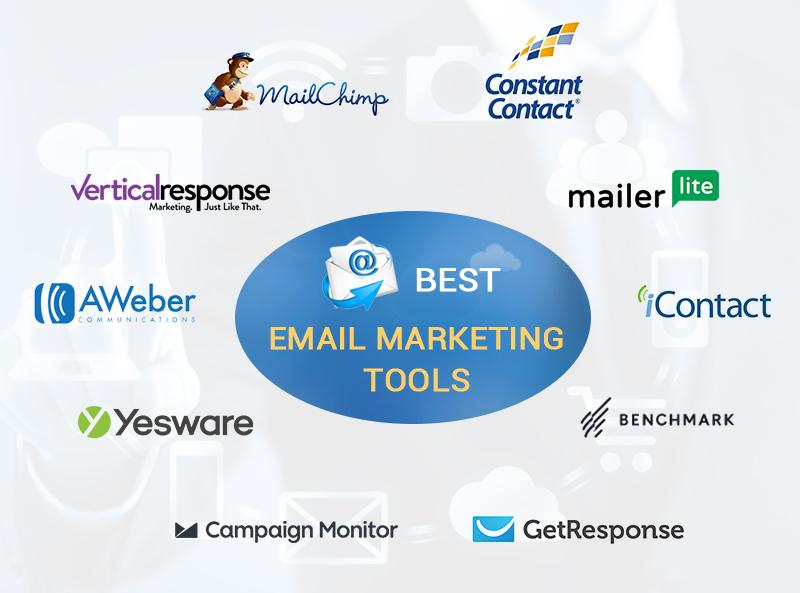
Key Features to look for in an Email Marketing Tool
When selecting an email marketing tool,there are several key features that can make or break your campaign success. Understanding these essentials will ensure you choose a platform that not only meets your current needs but also grows with your business. Here are some critical elements to consider:
- User-Friendly Interface: A clean, intuitive interface is basic for easy navigation. Look for tools that allow you to create, edit, and manage campaigns without a steep learning curve.
- Segmentation and Targeting: Your audience isn’t one-size-fits-all. The best platforms offer advanced segmentation options, enabling you to target specific groups based on demographics, behavior, and engagement levels.
- Responsive Design: Ensure the tool supports responsive email designs. With a meaningful amount of emails being opened on mobile devices, your campaigns should look great on any screen size.
- Automation Capabilities: Automation features save time and boost efficiency. Look for tools that allow you to set triggers and automatically send personalized emails based on user actions.
Additionally, consider the following features that can elevate your email marketing experience:
- A/B Testing: The ability to test different subject lines, content formats, and sending times is invaluable. A/B testing helps you optimize your campaigns based on real data.
- Analytics and Reporting: Robust analytics will give you insights into open rates, click-through rates, and overall engagement. This data is crucial for refining your strategy.
- Integration Options: Your email tool should easily integrate with other platforms you’re using, such as CRM systems, e-commerce solutions, and social media channels. This ensures smoother workflows and data synchronization.
- Scalability: as your business grows, so will your email marketing needs. Choose a platform that can scale with you, offering features that cater to larger lists and more complex campaigns.
To help you visualize these features, here’s a quick comparison table of different tools based on thier standout characteristics:
| Email Marketing Tool | User-Friendly | automation | A/B Testing | Analytics |
|---|---|---|---|---|
| Tool A | ✔️ | ✔️ | ✔️ | ✔️ |
| Tool B | ✔️ | ❌ | ✔️ | ✔️ |
| Tool C | ❌ | ✔️ | ✔️ | ✔️ |
Ultimately, choosing the right email marketing tool hinges on understanding your unique requirements. By focusing on these key features, you’ll be well-equipped to select a platform that aligns perfectly with your marketing goals and strategies.

Exploring User-Friendly interfaces for Effortless Campaign Management
In today’s fast-paced digital landscape,the success of your email marketing campaigns heavily relies on the usability of the platforms you choose. A user-friendly interface can make all the difference, transforming complex operations into seamless processes. Here are some key features that make email marketing platforms stand out:
- Drag-and-Drop Builders: look for platforms that offer intuitive drag-and-drop email builders. these tools allow you to create stunning emails without any coding knowledge, making it easy to personalize your campaigns.
- customizable Templates: A library of pre-designed templates can significantly reduce setup time. Choose platforms that allow you to easily modify these templates to match your brand’s identity.
- Smart Automation Tools: The best platforms include automation features that help you send the right messages at the right time. Look for tools that offer triggers based on user behavior, such as abandoned cart emails or welcome series.
- Responsive Design: ensure that the platform supports responsive design. Your emails should look great on any device,maximizing engagement regardless of how your subscribers view them.
- Real-Time Analytics: Having access to real-time metrics is crucial. platforms that provide insights into open rates, click-through rates, and subscriber engagement can help you refine your strategies.
When comparing various platforms, consider creating a feature comparison table to visualize the strengths of each option. Here’s a simple example:
| Platform | Drag-and-Drop Builder | Automation Features | Responsive Design | Real-Time Analytics |
|---|---|---|---|---|
| Mailchimp | ✔️ | ✔️ | ✔️ | ✔️ |
| Constant contact | ✔️ | ✔️ | ✔️ | ✔️ |
| Sendinblue | ✔️ | ✔️ | ✔️ | ✔️ |
| HubSpot | ✔️ | ✔️ | ✔️ | ✔️ |
Ultimately, the goal is to choose a platform that feels intuitive to you and your team. A user-friendly interface not only saves time but also enhances the overall effectiveness of your campaigns. As you explore different options, prioritize platforms that empower you to engage your audience effortlessly.
How Automation Can Transform Your Email Marketing strategy
Email marketing has evolved dramatically over the years,and one of the most significant advancements is the rise of automation. By leveraging automation, businesses can streamline their marketing efforts, providing a more personalized experience for their customers without overwhelming their teams. Imagine sending out tailored content to your audience at just the right moment—this is the power of automation.
One of the standout benefits of automating your email marketing strategy is the ability to segment your audience effectively. With automation tools, you can easily categorize your subscribers based on their behavior, preferences, and engagement levels.This means you can send targeted emails that resonate with specific groups, leading to higher open rates and conversions. As an example:
- Behavioral triggers: Send messages based on actions users take, like cart abandonment or product views.
- Demographic segmentation: Tailor content according to age, location, or interests.
- Engagement levels: Re-engage dormant subscribers with special offers or updates.
Automation also allows for timely interaction that enhances customer relationships. Imagine being able to send welcome emails as soon as someone subscribes or birthday greetings to make your customers feel valued.These timely messages create a personal touch that can significantly improve customer loyalty. Automation ensures that your audience receives the right message at the right time, making your marketing efforts feel seamless and thoughtful.
Furthermore, with automation, you can save countless hours that woudl otherwise be spent on manual tasks. Instead of crafting individual emails or reminders, you can set up workflows that run on autopilot. Whether it’s nurturing leads through a drip campaign or sending regular newsletters, automation frees up your time to focus on strategy and creativity.Just imagine what you could achieve with that extra bandwidth!
let’s talk about analytics. Automation platforms often come with robust analytics tools that help you track the performance of your campaigns. You can monitor open rates, click-through rates, and overall engagement, allowing you to refine your strategy continually. With this data at your disposal, you can make informed decisions and adjust your approach in real-time. Here’s a quick look at how analytics can enhance your strategy:
| Metric | What It Tells You |
|---|---|
| Open Rate | How compelling your subject lines are. |
| Click-Through Rate | The effectiveness of your call-to-action. |
| Unsubscribe Rate | How well your content resonates with readers. |
In a world where consumer preferences change rapidly, automation in email marketing is not just a luxury; it’s a necessity. By utilizing automated tools, you can create a more personalized and engaging experience for your audience, drive conversions, and ultimately build lasting relationships with your customers. The future of your email marketing strategy awaits, and automation is the key to unlocking its full potential.
Comparing Pricing Models Across the Top Platforms
When it comes to choosing an email marketing platform, the pricing models can often be as diverse as the features they offer. Understanding these pricing structures is crucial to finding a solution that fits your budget while still meeting your marketing needs. Let’s take a closer look at how different platforms price their services.
Most email marketing platforms utilize one of the following pricing models:
- Pay-as-you-go: this model allows you to pay for the number of emails sent without committing to a monthly fee.this is ideal for businesses that have fluctuating email marketing needs.
- Subscription-based: Here, you pay a monthly or annual fee based on the number of subscribers or emails sent. This model typically comes with tiered pricing,offering more features at higher levels.
- Freemium: Some platforms provide a basic version for free,giving access to limited features or a cap on the number of subscribers. Upgrading to a paid version unlocks additional functionalities.
To illustrate how these models compare across popular platforms, here’s a brief overview:
| Platform | Pricing Model | Starting Price | Free Trial |
|---|---|---|---|
| Mailchimp | Subscription-based | $10/month | Yes, up to 2,000 contacts |
| Sendinblue | Pay-as-you-go | $25 for 10,000 emails | Yes, unlimited contacts |
| Constant Contact | Subscription-based | $20/month | yes, 60 days |
| AWeber | Subscription-based | $19/month | Yes, 30 days |
While the initial costs may seem straightforward, it’s essential to consider what you get for your money. Some platforms may appear cheaper but lack critical features such as automation, advanced analytics, or customer support, which can impact your overall marketing strategy.
Additionally, be mindful of any hidden fees associated with exceeding subscriber limits or additional email sends. Carefully reviewing the fine print can lead to significant savings and help ensure you don’t encounter unexpected costs down the line.
Ultimately, choosing the right pricing model requires balancing your immediate budget with long-term goals. Assess your email marketing objectives, desired features, and growth potential to find the best fit for your association. Remember, investing in a solid platform can ultimately yield a strong return on investment through enhanced customer engagement and increased sales.

Integrations that Matter: Connecting Your Email with Other Tools
In today’s fast-paced digital landscape, the ability to integrate your email with other tools is more crucial than ever. By connecting your email marketing platform to various applications, you can streamline your workflows, enhance your customer experience, and ultimately drive better results. here are some integrations that really matter:
- CRM Software: Linking your email marketing platform with a CRM like Salesforce or HubSpot allows for better segmentation and targeting. You can personalize your campaigns based on customer data, improving engagement rates.
- Social Media Platforms: Integrating social media channels enables you to share your email content across different platforms effortlessly.This not only expands your reach but also helps in repurposing content for wider visibility.
- E-commerce Solutions: Tools like Shopify and WooCommerce can be seamlessly integrated to automatically sync customer data. This means you can tailor your email campaigns based on past purchases, abandoned carts, or product recommendations.
- Analytics Tools: Connecting your email platform with Google analytics or other analytics tools provides deeper insights into campaign performance. You can track user behavior post-click, allowing for more informed decisions in your marketing strategy.
Moreover, consider integrating with automation tools such as Zapier or Integromat. These platforms allow you to create workflows that automate repetitive tasks. As an example,you can set up a trigger that adds new subscribers from your email list to a specific social media audience,saving you valuable time and ensuring consistency across your marketing efforts.
| Integration Type | Benefits |
|---|---|
| CRM | Improves targeting and personalization. |
| Social Media | enhances content reach and engagement. |
| E-commerce | Personalizes offers based on purchase data. |
| Analytics | Provides actionable insights to refine strategies. |
| Automation | Streamlines workflows and saves time. |
Lastly, remember that the right integrations can significantly impact your overall strategy. They not only enhance the user experience but also empower your marketing team to work more efficiently. Take the time to explore available integrations within your email marketing platform, and don’t hesitate to reach out to your providers for recommendations tailored to your specific business needs.

Analyzing Deliverability Rates: Ensuring Your Emails Reach the Inbox
When it comes to email marketing, deliverability is crucial. After all, what good is a well-crafted email if it never reaches your recipients’ inboxes? To ensure your emails land where they belong, it’s essential to understand the factors that influence deliverability rates.
Understanding the Basics: Deliverability refers to the ability of an email to successfully reach the inbox of your intended recipients. Several elements can impact this, including:
- Sender Reputation: This is influenced by how recipients interact with your emails. High open and click rates can boost your reputation, while spam complaints can harm it.
- Authentication Protocols: Implementing protocols like SPF, DKIM, and DMARC helps verify your identity as a sender, increasing trust with email service providers (ESPs).
- List Hygiene: Maintaining a clean email list by removing inactive or bounced emails can significantly improve your deliverability rates.
Monitoring Metrics: Keeping an eye on key performance indicators (KPIs) is vital for analyzing your email campaigns. Here are the most vital metrics to track:
| Email Metric | Description |
|---|---|
| Open Rate | The percentage of recipients who opened your email. |
| Click-Through Rate (CTR) | The ratio of users who click on a link within your email to the total number of recipients. |
| Bounce Rate | The percentage of emails that couldn’t be delivered to recipients. |
| Unsubscribe Rate | The rate at which recipients opt out from your mailing list. |
Testing and Optimization: Regularly testing your email campaigns can provide insights into what works and what doesn’t. A/B testing subject lines, content, and even send times can yield valuable data. Additionally, using tools to analyze your email content for spam triggers can help you refine your approach and avoid the dreaded spam folder.
Choosing the Right Platform: Not all email marketing platforms are created equal when it comes to deliverability. It’s important to select a platform that prioritizes deliverability and offers features that assist in improving your rates. Look for platforms that provide:
- Dedicated IP Addresses: This can help improve your sender reputation by having a unique identity.
- Advanced Analytics: detailed reporting tools to track performance metrics.
- Compliance Support: Features that help you adhere to regulations like GDPR and CAN-SPAM.
understanding and actively managing your email deliverability rates can make a world of difference to your marketing efforts. By focusing on your sender reputation, monitoring metrics, optimizing your campaigns, and choosing the right platform, you can ensure that your emails not only reach the inbox but also engage your audience effectively.
Customer Support: Why It’s Crucial for Your Email Marketing Success
In the fast-paced world of email marketing, having a robust customer support system can make all the difference between a accomplished campaign and a frustrating experience. When your audience encounters issues or has questions, timely and effective support can turn potential problems into opportunities for engagement and loyalty.
consider how your customers interact with your emails. Whether it’s a forgotten password, a need for assistance with managing subscriptions, or inquiries about specific campaigns, a responsive customer support team can:
- Enhance Customer Experience: Quick responses to inquiries foster a sense of trust and reliability.Customers appreciate when their concerns are addressed promptly.
- Reduce Unsubscribes: When users encounter issues, they may be inclined to unsubscribe. Efficient support can help resolve their problems and retain their interest.
- Gather Feedback: Customer support interactions frequently enough yield valuable insights into user experiences. This feedback can inform necessary adjustments in your strategies.
Moreover,effective customer support can enhance your email marketing efforts by providing resources that empower your customers. Here’s how:
| Customer Support Resource | Benefit |
|---|---|
| FAQs | Addresses common concerns, reducing repetitive inquiries. |
| Live Chat | Offers instant assistance, increasing customer satisfaction. |
| tutorials and Guides | Helps customers navigate your services, enhancing user experience. |
Additionally, 24/7 support can be a game-changer. With customers around the globe, providing assistance at all hours ensures that no one feels neglected. This availability communicates that you value their time and their business, creating a bond that can enhance loyalty.
Lastly, remember that customer support is not just about resolving issues; it’s also about building relationships. By investing in a strong support system and training your team to go the extra mile, you create an environment where customers feel valued, leading to more successful email marketing campaigns.

Real User Reviews: What Customers Are saying About These Platforms
What Customers Are Saying About These Platforms
When it comes to choosing an email marketing platform, real user experiences can provide invaluable insights. Here’s a glimpse into what customers are saying:
Mailchimp
Users rave about Mailchimp for its user-friendly interface and robust analytics.Many appreciate the following:
- Easy Setup: New users find it simple to get started,making it ideal for small businesses.
- Comprehensive Analytics: Customers love the detailed reports that help them track performance.
Constant Contact
Constant Contact fans often highlight its excellent customer service. Users have noted:
- Responsive Support: Many have praised the quick and helpful responses from the support team.
- Event management: The event marketing tools are a significant hit for businesses that host events.
SendinBlue
Customers using SendinBlue frequently mention its affordability and features. Key points include:
- Cost-Effective Plans: Users appreciate the competitive pricing, especially for startups.
- SMS Marketing: The added SMS marketing feature is a game-changer for some businesses.
AWeber
Users of AWeber often emphasize its ease of use, particularly for email automation. Highlights include:
- Drag-and-Drop Editor: Many find it intuitive, allowing quick email design without technical skills.
- Strong Automation Tools: Reviewers appreciate the powerful automation capabilities for nurturing leads.
ActiveCampaign
For those utilizing ActiveCampaign, the marketing automation features are frequently mentioned as a standout. Users have noted:
- Advanced Segmentation: Customers value the ability to target specific audiences effectively.
- Integration Options: Reviewers appreciate how well it connects with other tools they use.
Customer Satisfaction Overview
| Platform | Rating (out of 5) | Notable Feature |
|---|---|---|
| Mailchimp | 4.5 | user-Friendly Interface |
| Constant Contact | 4.7 | Customer Support |
| SendinBlue | 4.3 | SMS Marketing |
| AWeber | 4.6 | Email Automation |
| ActiveCampaign | 4.8 | Advanced Segmentation |
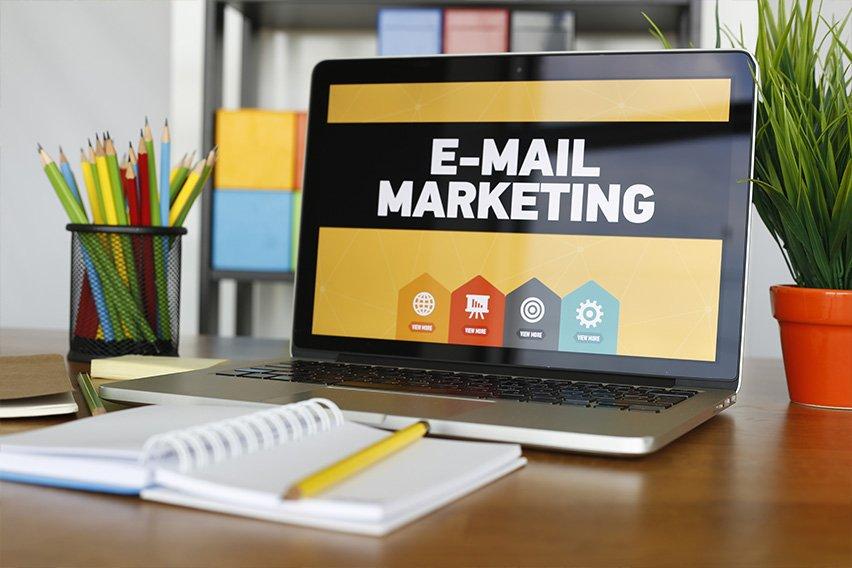
Best Platforms for Small Businesses vs. Enterprises
When it comes to choosing the right email marketing platform, small businesses and enterprises have different needs and priorities that influence their decision-making. Understanding these nuances can make the difference between a successful campaign and a missed opportunity.
For small businesses, the focus frequently enough leans towards affordability, ease of use, and essential features that allow them to create impactful campaigns without overwhelming complexity. They thrive on platforms that offer:
- Intuitive Interfaces: A user-friendly design helps small business owners quickly navigate tools and features without extensive training.
- Cost-Effective Plans: Budget constraints are common; thus, platforms with flexible pricing and free trials or freemium options are highly desirable.
- Essential Marketing Features: Tools like automated campaigns, basic analytics, and simple list management are crucial for effective engagement.
On the other hand,enterprises typically require more robust solutions that can handle various complexities associated with larger operations. They often prioritize platforms that offer:
- advanced Analytics: Comprehensive reporting and insights that help track campaign performance and customer behavior.
- Scalability: Platforms that can grow with their business, accommodating more subscribers and sophisticated marketing strategies.
- Custom integrations: The ability to connect seamlessly with other enterprise systems (like CRM tools) for streamlined data flow and enhanced automation.
To illustrate the differences further, here’s a comparison of popular platforms suited for small businesses versus those tailored for enterprise needs:
| Platform | Best For | Key Features |
|---|---|---|
| Mailchimp | Small Businesses | Easy-to-use templates, automation, basic reporting |
| Sendinblue | Small Businesses | Affordable plans, SMS marketing, simple automation |
| HubSpot | Enterprises | Advanced analytics, CRM integration, extensive automation |
| Marketo | Enterprises | Lead management, custom workflows, powerful analytics |
Ultimately, the best platform will depend on your business size, budget, and specific marketing goals. Small businesses should seek user-friendly, cost-effective solutions, while enterprises will benefit from sophisticated, scalable platforms that can handle their extensive needs. Choosing the right tool is key to building successful email marketing campaigns that resonate with your audience, regardless of your business size.

Case Studies: Success Stories from Top Email Marketing Users
In the world of email marketing, success stories serve as powerful motivators. Here are some inspiring examples of businesses that have harnessed the power of top email marketing platforms to achieve remarkable results.
1.E-commerce Brand Boosts Revenue
A well-known e-commerce brand utilized a leading email marketing service to personalize their campaigns. By segmenting their audience based on purchase history and behavior, they crafted targeted emails that included product recommendations. The results?
- 30% increase in open rates
- 25% boost in conversion rates
- $100,000 additional revenue within three months
2. Nonprofit Organization’s Fundraising Triumph
A nonprofit organization turned to email marketing to increase awareness and drive donations for their cause. They implemented a series of automated campaigns to educate supporters and encourage contributions. The outcome was astounding:
| Campaign Type | results |
|---|---|
| Monthly Newsletter | 60% open rate |
| Donation Drives | 150% increase in donations |
| Event Promotion | Sold out event |
3.SaaS Company Increases User Engagement
A SaaS company leveraged advanced analytics from their email marketing platform to track user engagement. By sending personalized onboarding emails and follow-ups based on user activity, they significantly improved user retention. The statistics speak volumes:
- 40% decrease in churn rate
- 50% higher user engagement
- 20% more upgrades to premium plans
4. Resturant Chain Drives Foot Traffic
A national restaurant chain crafted mouth-watering email campaigns to entice local customers. Using geolocation data, they sent targeted offers to customers based on their location. The results were delicious:
- 15% increase in foot traffic
- 35% boost in promotional redemptions
- high customer satisfaction ratings
These case studies illustrate how diverse businesses can benefit from the right email marketing platform. Whether you’re looking to enhance engagement, boost sales, or drive donations, the success stories from these top users prove that with the right strategies, the possibilities are endless.

Final Thoughts on Selecting the Perfect Email Marketing Platform
Choosing the right email marketing platform can feel like navigating a maze, especially with so many options available. However, by focusing on a few key factors, you can make the decision much easier. Start by identifying your specific needs: Are you a small business looking to grow your subscriber list, or are you a larger company needing advanced automation features? Understanding your goals sets the foundation for a successful selection process.
The user interface is another vital aspect to consider. A clean, intuitive interface can significantly reduce the learning curve and enhance your overall experience. Look for platforms that offer drag-and-drop features for designing emails, as these make the process much more enjoyable and efficient. Remember, even the most powerful tools can fall flat if they are difficult to navigate.
Integrations play a crucial role in streamlining your marketing efforts. Ensure that the platform you choose can easily connect with other tools you’re already using, such as your website, CRM, and social media channels. This not only saves you time but also ensures a cohesive strategy across your marketing initiatives.
Here’s a quick comparison of some of the standout features to look for in an email marketing platform:
| Feature | Platform A | platform B | Platform C |
|---|---|---|---|
| User-Friendly Interface | ✔️ | ✔️ | ❌ |
| Automation Capabilities | ✔️ | ❌ | ✔️ |
| Segmentation Options | ✔️ | ✔️ | ✔️ |
| Analytics and Reporting | ❌ | ✔️ | ✔️ |
Don’t forget about pricing. Many platforms offer a tiered pricing structure based on the number of subscribers or features. It’s essential to evaluate not just the initial costs but also how your investment can grow with your business. Look for platforms that provide a good balance of features without breaking the bank.
Lastly, consider customer support. A responsive support team can be a lifesaver, especially if you encounter issues or have questions. Look for platforms that offer multiple support channels, such as live chat, email, and robust documentation.
the perfect email marketing platform will cater to your unique needs while providing the tools necessary to execute effective campaigns. By weighing these factors carefully, you’ll be well on your way to making an informed choice that will benefit your business in the long run.
Frequently Asked Questions (FAQ)
Q&A: A Guide to the 14 Best Email Marketing Platforms
Q: What is email marketing, and why is it critically important?
A: Great question! Email marketing is a powerful tool that allows businesses to communicate directly with their customers via email.It’s important because it helps build relationships, nurture leads, and ultimately drive sales. Actually, for every $1 spent on email marketing, the average return is $42! So, if you’re not using it yet, you’re missing out on a fantastic opportunity.
Q: With so many email marketing platforms out there, how do I choose the right one?
A: It can definately be overwhelming with all the options available! Start by identifying your specific needs—like whether you need automation features, integration with other tools, or advanced analytics. Also, consider your budget and the ease of use of the platform. A good email marketing platform should not only meet your current needs but also grow with you as your business evolves.
Q: Can you share some of the top email marketing platforms mentioned in the article?
A: Absolutely! Some of the standout platforms include Mailchimp, known for its user-friendly interface; Constant Contact, which excels in customer support; and Sendinblue, which offers robust automation features. Each platform has its unique strengths, so it’s essential to find one that aligns with your marketing goals.
Q: What should I look for in an email marketing platform?
A: Look for features like customizable templates, segmentation options, A/B testing capabilities, and reporting tools.These features will help you create engaging campaigns and measure their effectiveness. Additionally, consider whether the platform offers integration with your existing tools, like your CRM or e-commerce site, to streamline your workflow.
Q: are these platforms suitable for both small businesses and large enterprises?
A: Yes! Most of the platforms we discuss in the article cater to a range of business sizes. While some may be more tailored to small businesses with budget-friendly plans, others offer advanced features that larger enterprises might need. The key is to choose a platform that fits your current size while allowing for scalability as you grow.
Q: What are some common mistakes to avoid when using email marketing platforms?
A: A few common pitfalls include neglecting to segment your audience, failing to optimize for mobile users, and not testing your emails before sending. Ignoring these aspects can lead to lower engagement rates and wasted resources. Always remember to analyze your results and refine your strategy based on what’s working!
Q: Can I use email marketing for more than just selling products?
A: Absolutely! Email marketing is incredibly versatile.You can use it to share valuable content, promote events, announce company news, or even gather feedback from your audience.the key is to provide value to your subscribers, building trust and encouraging loyalty over time.
Q: How frequently enough should I send emails to my subscribers?
A: Finding the right frequency can vary by audience, but a good rule of thumb is to aim for consistency—whether that’s weekly, bi-weekly, or monthly. The key is to keep your audience engaged without overwhelming them. Monitor your open rates and adjust as necessary to find the perfect balance!
Q: What’s the takeaway from the article?
A: The takeaway is simple: choosing the right email marketing platform can transform your business communication and drive significant results. take the time to explore your options, consider your unique needs, and don’t hesitate to experiment with different strategies. With the right tools in hand, you’ll be well on your way to mastering email marketing!
Feel free to use this Q&A section to engage your readers and help them understand the value of choosing the right email marketing platform!
In Retrospect
As we wrap up this guide to the 14 best email marketing platforms, it’s clear that the right tool can make all the difference in your marketing efforts. Whether you’re a small business owner looking to engage your first customers or a seasoned marketer aiming to refine your campaigns, there’s a perfect fit waiting for you among these options.
Remember, effective email marketing isn’t just about sending messages; it’s about building relationships and nurturing connections. With the right platform, you can streamline your process, enhance your campaigns, and ultimately, drive real results for your business.
So, take the plunge! Dive into the features, compare pricing, and think about your specific needs.The world of email marketing is at your fingertips,and with the right platform,you can take your outreach to the next level. Happy emailing, and may your inbox be filled with engaged readers and loyal customers!

